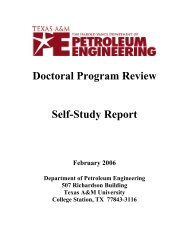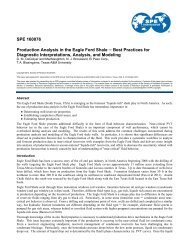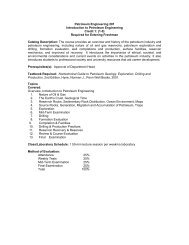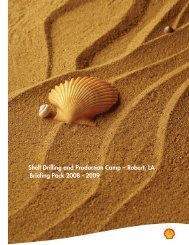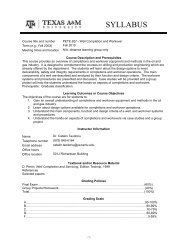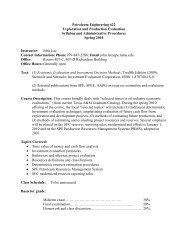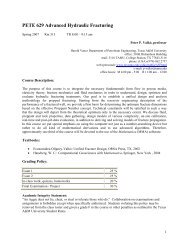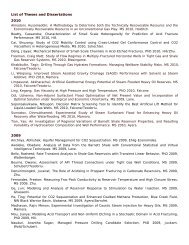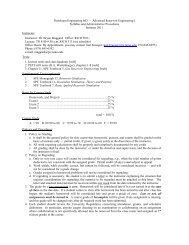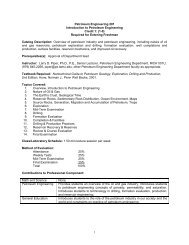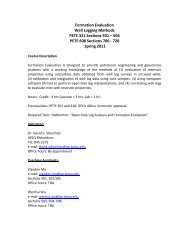Crisman Annual Report 2009 - Harold Vance Department of ...
Crisman Annual Report 2009 - Harold Vance Department of ...
Crisman Annual Report 2009 - Harold Vance Department of ...
Create successful ePaper yourself
Turn your PDF publications into a flip-book with our unique Google optimized e-Paper software.
Thermo-Poroelastic Finite Element Analysis <strong>of</strong> Rock Deformation and Damage<br />
Introduction<br />
Stress change and permeability variations caused<br />
by rock failure play an important role in geothermal<br />
reservoir development, particularly in understanding<br />
stimulation outcomes and induced seismicity.<br />
Cold water injection causes significant change in<br />
temperature, pore pressure, and thus the stresses<br />
near the wellbore and in the reservoir which, in turn<br />
influence rock permeability.<br />
Permeability (md)<br />
22<br />
20<br />
18<br />
16<br />
14<br />
12<br />
10<br />
8<br />
6<br />
1 sec<br />
10 sec<br />
30 sec<br />
Objectives<br />
In this work, we present the development <strong>of</strong> a fullycoupled<br />
thermo-poro-mechanical finite element<br />
model with damage mechanics and stress dependent<br />
permeability for simulating rock response to cold<br />
water injection.<br />
4<br />
2<br />
0<br />
1<br />
2<br />
3<br />
r/a<br />
Permeability distributions around the wellbore.<br />
14<br />
4<br />
5<br />
Stress (MPa)<br />
140<br />
120<br />
100<br />
80<br />
60<br />
1.0<br />
0.8<br />
0.6<br />
0.4<br />
Damage<br />
Pore Pressure (MPa)<br />
12<br />
10<br />
8<br />
6<br />
4<br />
1 sec<br />
30 sec<br />
ref-1 sec<br />
ref-30 sec<br />
40<br />
0.2<br />
Stress<br />
20<br />
Damage<br />
0<br />
0.005 0.010 0.015 0.020 0.025 0.030<br />
r/a<br />
Finite element simulations <strong>of</strong> a triaxial test. Green line: brittle behavior<br />
<strong>of</strong> strain-stress relationships; red line: damage evolution when stresses<br />
satisfy the failure criterion.<br />
Approach<br />
Both conductive and convective heat transport are<br />
considered in the thermo-poroelastic formulation.<br />
The model is used to perform a series <strong>of</strong> numerical<br />
experiments to study the influence <strong>of</strong> cold water<br />
injection on rock damage and permeability<br />
enhancement. The rock damage is reflected in the<br />
alteration <strong>of</strong> its elastic modulus and permeability.<br />
Accomplishments<br />
The results show that damage propagation is<br />
accompanied by a relaxation <strong>of</strong> the effective stress<br />
in the damage zone and its concentration in the<br />
intact rock near the interface with the damage zone.<br />
2<br />
0<br />
1<br />
2<br />
Pore pressure distributions around the wellbore. Solid lines represent<br />
pore pressure distributions for damage; Dashed lines give the results for<br />
the reference case with no damage.<br />
Significance<br />
The model provides a tool for the analysis <strong>of</strong> stress<br />
induced micro-seismicity and fracture propagation<br />
in geothermal and petroleum reservoirs.<br />
CRISMAN INSTITUTE<br />
Project Information<br />
3.1.21 Reservoir Geomechanics: Thermo-Poroelastic<br />
Analysis <strong>of</strong> Rock Deformation and Damage<br />
Contacts<br />
Ahmad Ghassemi<br />
979.845.2206<br />
ahmad.ghassemi@pe.tamu.edu<br />
3<br />
r/a<br />
4<br />
5<br />
Sang Hoon Lee<br />
70<br />
<strong>Crisman</strong> <strong>Annual</strong> <strong>Report</strong> <strong>2009</strong>



